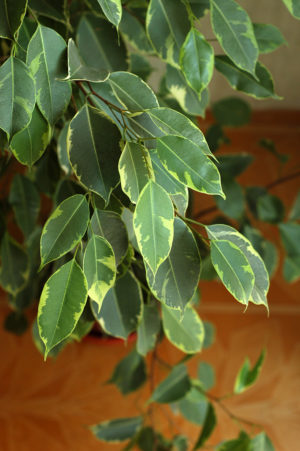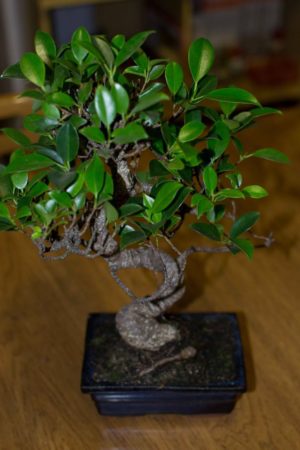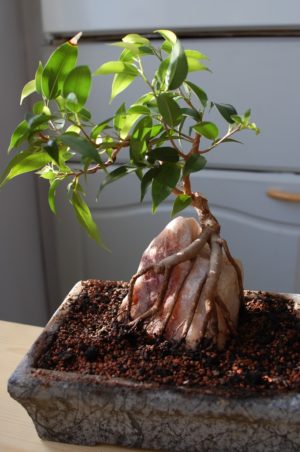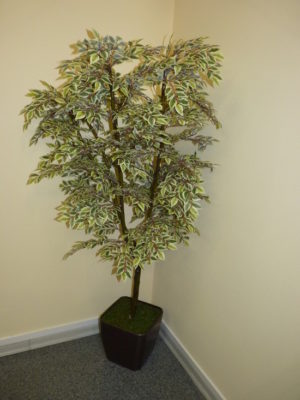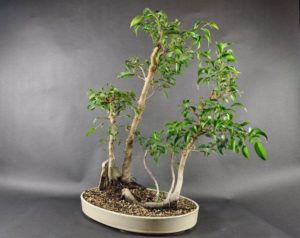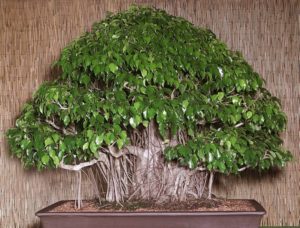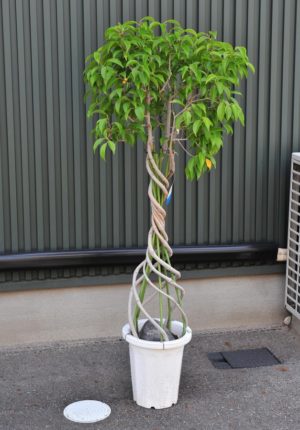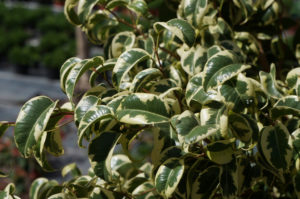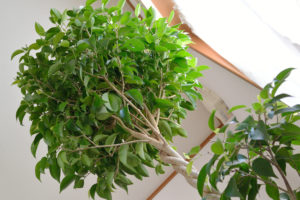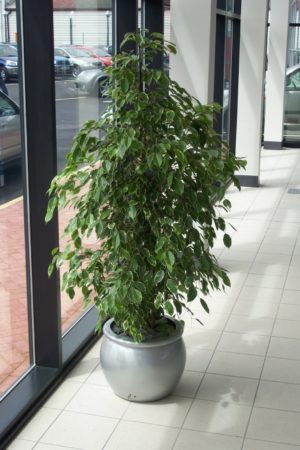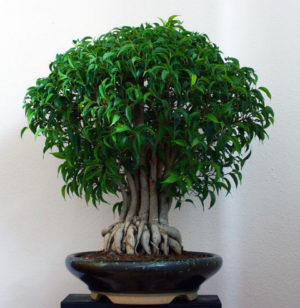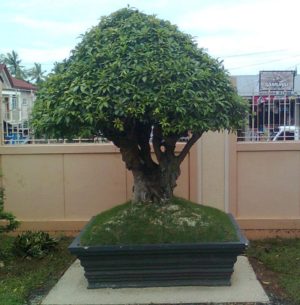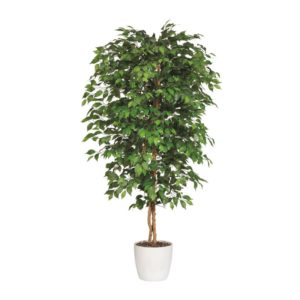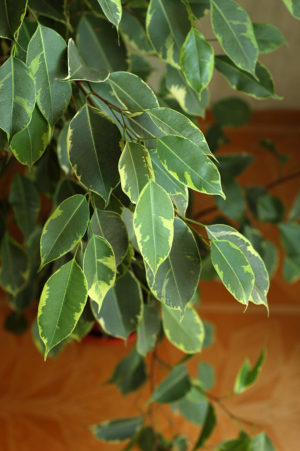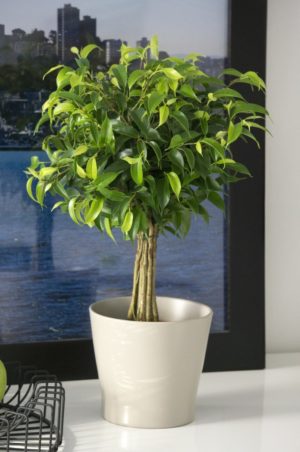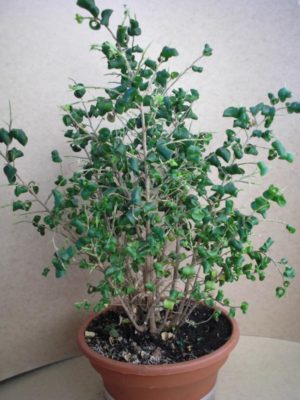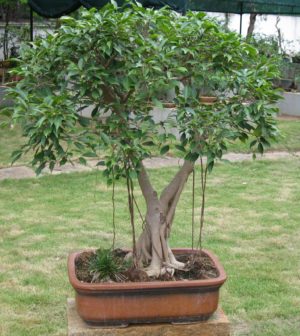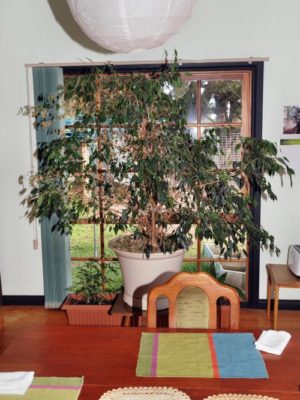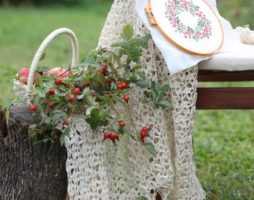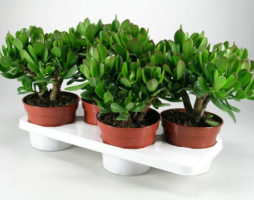Ficus is one of the most popular indoor plants. He perfectly adapts almost at home, although he himself comes from tropical latitudes. There are many varieties of this type of plant. The most popular among the rest is Benjamin's ficus. Care at home does not require much effort, but compliance with the basic rules of maintenance is mandatory.
- plant description
- Features of home care
- Soil properties and varieties
- Correct layering
- How to choose the right soil mix
- Signs of unsuitable soil
- Soil replacement frequency
- Optimal lighting mode
- Irrigation Features
- make-up
- Correct transplant rules
- Pruning and propagation
- Photo Gallery: Ficus Benjamin
- Video
plant description
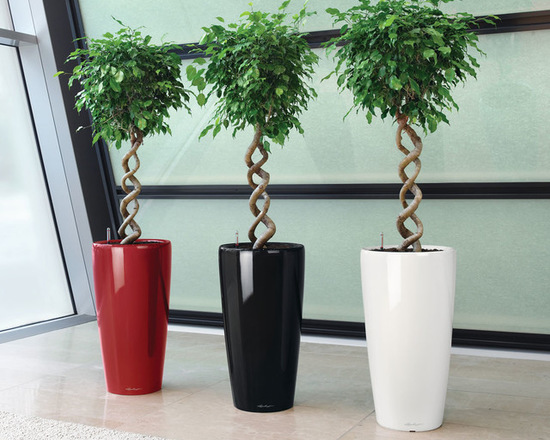
ficus is one of the most popular indoor plants
Decorative ficus is a small tree. Characteristic is a shortened trunk, covered with a smooth grayish-beige bark, a branched crown.
The plant comes from the tropics, so the root system forms branches under, above the ground. Numerous aerial roots act as an additional support. The formation of a banyan is possible only with a sufficiently high humidity. In drought conditions, aerial roots practically do not form.

ficus feels great in a dark place from direct sunlight
In its native lands, the tree grows to a height of 25-30 m. The maximum height when kept at home or in the office is 2-3 m. Foliage is of medium density with a dark green core, light, grayish-white edges. Because of this coloring, Benjamin's ficus is also called variegated. Each leaf, having an oval shape, a pointed top, reaches a length of 7-13 cm, a width of 2-6 cm.
Indoor species do not differ in large sizes, but please the eye with a neat deciduous crown. Thanks to its variegated color, the plant is able to enliven any interior.

with the help of ficus Benjamin, the interior of the living room looks cozy at home
Features of home care
At first glance, the flower is quite unpretentious, but in order for the tree to be healthy and beautiful, a number of simple recommendations should be followed. What should be the care at home for ficus Benjamin.
Soil properties and varieties

in warm weather, Benjamin's ficus will become a bright decoration of the facade of the house
As with all indoor plants, the quality of the soil plays a big role. You can use special soil purchased at the store. However, the best option is to make it yourself. As Benjamin's decorative ficus grows, it will be necessary to change not only the soil lump itself, but also to regulate its composition.

Ficus Benjamin attracts with its decorative effect and unpretentiousness
The proportion of the main components is determined based on two criteria:
- flower age;
- its size, in particular, the volume of root branches.
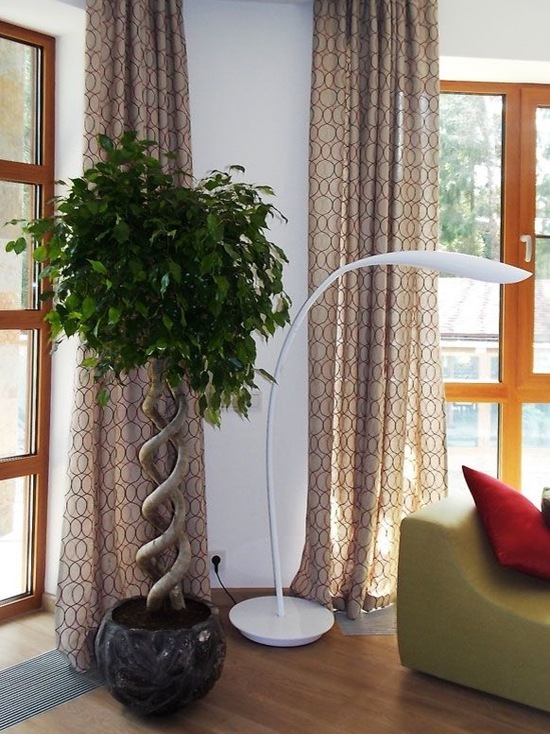
ficus should be placed in a ventilated area
Depending on the age of the houseplant, the optimal ratio is:
- For young trees, the proportion is 1: 1:
- part of leaf humus;
- part of fine river sand;
- part of the peat.
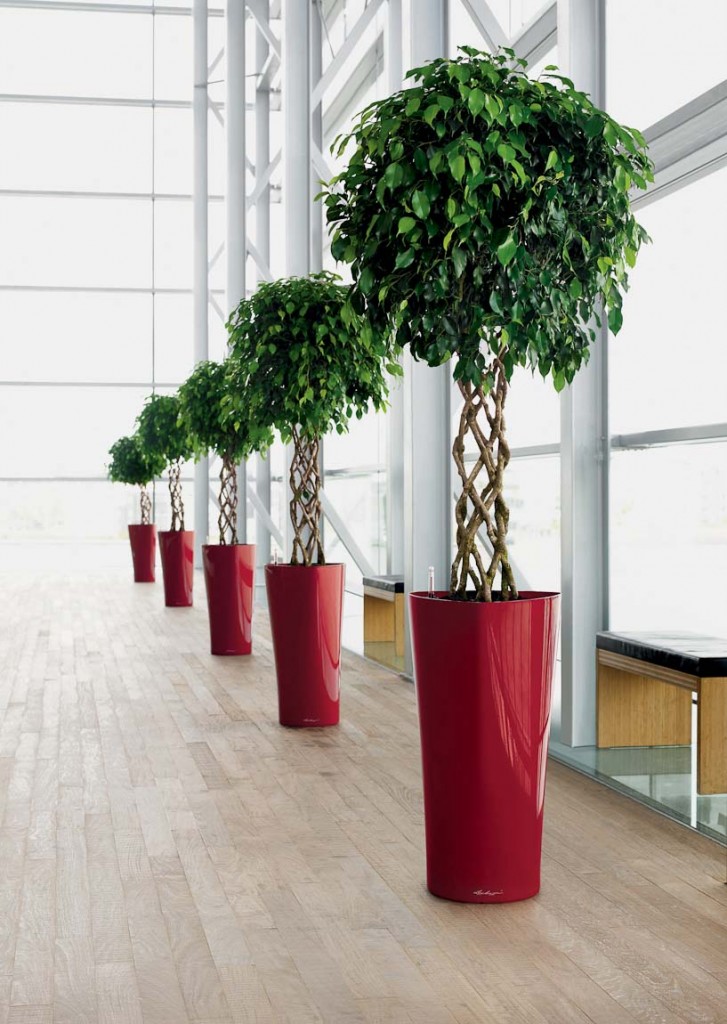
tall ficus trees in large flowerpots are exhibited in non-residential premises: offices, hospital halls, etc.
- For mature plants, there are two options for the soil mixture:
- a portion of sifted sand, 2 portions of leaf humus, 2 parts of sod land;
- one part of sand, leaf, sod land, peat.
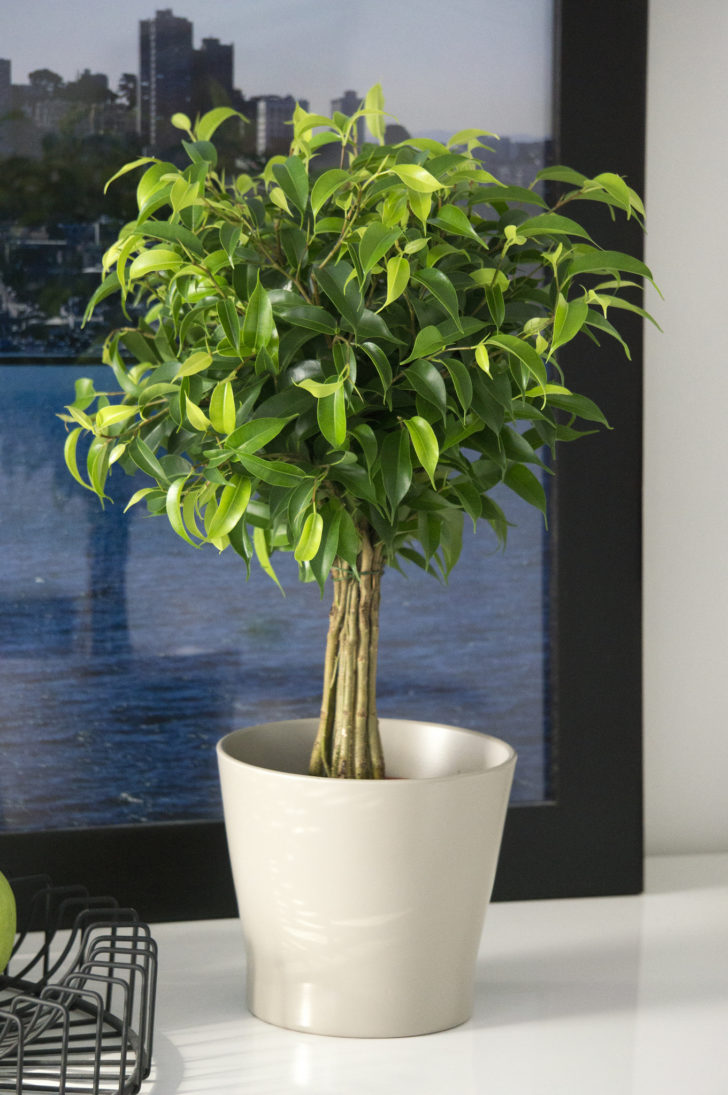
as the ficus grows, the composition of the soil should be adjusted
To make the soil lighter, looser, it is good to add a little coarse sand to the mixture. This soil consistency helps to strengthen the root system of indoor ficus Benjamin, the care of which involves maintaining optimal humidity, both in the soil itself and in the surrounding air.
Expanded clay improves the air permeability of the earth. When watering, fertilizing, the material absorbs excess liquid. Accumulating moisture, expanded clay feeds the root system of a houseplant with it when the soil layer dries up.

an adult ficus tree fits perfectly into the design of a spacious living room combined with a kitchen
In order to enrich, as well as loosen the earth, crushed charcoal or ash is added to the mixture. To feed the roots, biohumus, which is a waste product of earthworms, is used as an organic fertilizer, a natural growth stimulant.
With high acidity of the soil, it is recommended to add lime, dolomite flour. In addition, natural dolomite is a source of calcium, magnesium (promotes the synthesis of chlorophyll in plant cells).

when transplanting a ficus, its root system goes through an adaptation period
Correct layering
When preparing the soil mixture on your own, it is necessary to take into account the rules for compiling components, laying layers depending on their density.
At the bottom of the pot, it is imperative to lay out drainage from expanded clay. The size of the fraction is determined depending on the volume of the container for planting. The larger the bottom area, the larger the expanded clay should be.
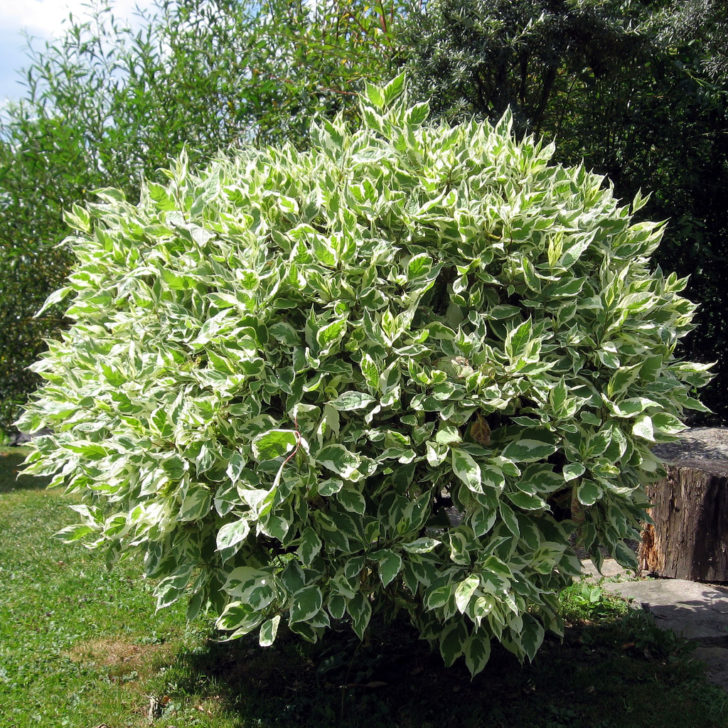
ficus growth depends on self-prepared soil mixture
Effective drainage can be made from charcoal by laying out one layer of particles of the same size. Coarse-grained sand is also suitable. However, if it is used, the bottom of the pot must be covered with a net so that sandy drainage does not spill out through the holes.
The next layer is a substrate prepared by one of the above methods. Approximately 2/3 of the volume of the pot is filled with the main mixture, the remaining third with a lighter layer. This may be land with a high content of peat, fine sand, ash.

varieties of ficus Benjamin: kinki, natasha, nicole
In the hot season, a layer of fine expanded clay is sometimes laid on the surface of the earth. After watering, it retains some of the moisture inside the particles, gives it away if necessary, preventing the earthen clod from drying out.
back to index ↑How to choose the right soil mix
There are countless different substrates on the shelves of specialized stores. Among them are both universal mixtures and those formulated taking into account the characteristics of indoor ficus Benjamin.

decoration of the recreation area with two parallel ficuses
One rule to keep in mind is that most ready-made soil mixes are not intended to be used as a stand-alone soil for planting. They are recommended to be added to ordinary soil, improving the breathability and moisture absorption of the layer. Failure to comply with this rule in most cases leads to a deterioration in the condition of indoor ficus and even to its death.
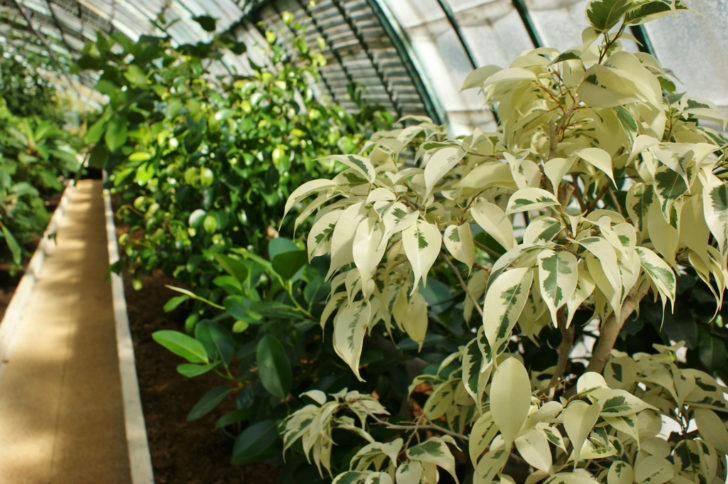
Ficus cultivar de dumbbell contrasts against the background of green vegetation
When choosing a finished substrate, you should pay attention to the composition.Conscientious manufacturers always indicate the list of components on the packaging. The main components of the mixture necessary for the effective growth of ficus Benjamin are:
- peat (high, lowland);
- river sand with different particle sizes (coarse-grained, fine-grained);
- expanded clay of different fractions (small, medium, large);
- a complex of fertilizers (mineral, organic).
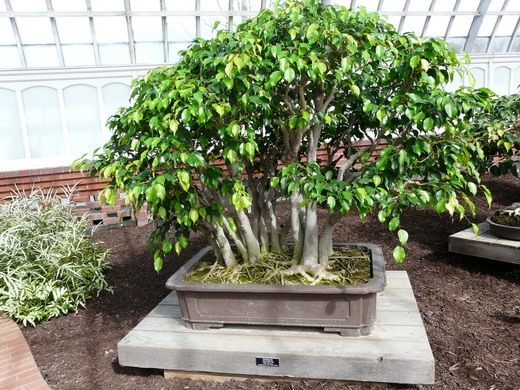
ficus benjamina can be kept outdoors at an air temperature of at least + 16C
You can carry out the initial planting in the finished substrate, adjusting its composition after some time. After 2-3 weeks, according to the condition of the leaves, the crown can determine whether this soil is suitable for the plant.
If the indoor flower does not shed foliage, has a rich color - the soil composition is suitable. A change in color, drying of the edges of the leaves, wilting of the branches indicates unfavorable conditions. However, the problem may not be only in the ground.
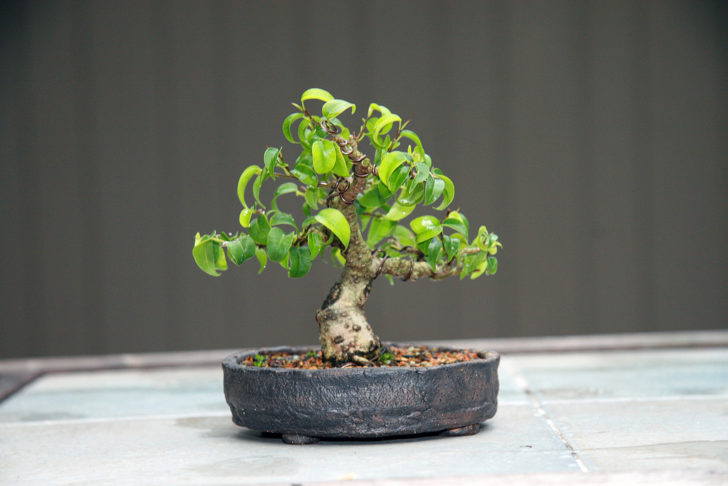
compact ficuses are an excellent choice for small apartments
Signs of unsuitable soil
If the topsoil is lumped together after watering, this indicates a high humus content. In small quantities, the organic component benefits by nourishing and enriching the roots with useful substances. Exceeding the norm leads to moisture retention, rotting of the root system, reproduction of fungi and parasites.
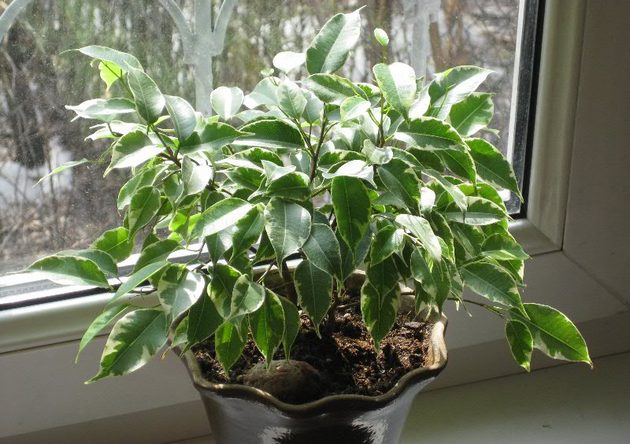
if indoor ficus sheds foliage, then the soil is not properly composed
The rapid drying of the soil layer indicates that the substrate contains a lot of peat. Too light and loose soil consistency leads to a lack of moisture in the roots. Drying out, as well as fluid stagnation, contribute to the development of diseases, the reproduction of pests, as a result of which the decorative ficus may die.
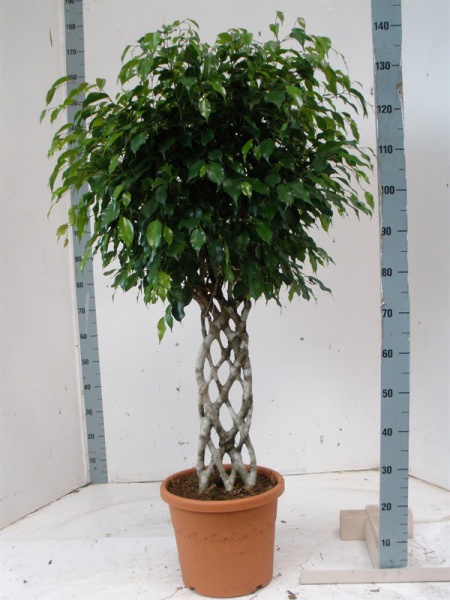
to give a spherical crown, young ficus shoots are pruned from February to May
Determining the condition of the soil is quite easy. It is necessary to carefully insert a long wooden skewer or stick into the earth layer. You can also check with your fingers. However, it should be remembered that it is recommended to work with the ground with rubber gloves. Easy penetration into the soil mixture to a depth of several centimeters is a sign of the correct consistency.

to create a comfortable seating area in the hallway, it is enough to place a small sofa, a lamp and a flowerpot with ficus
Moisture saturation is determined in a similar way. A wooden skewer or finger is immersed in the soil. If, after extraction, the surface remains moderately moist, with a small amount of earth, then the mixture is sufficiently moistened. Additional watering should be done when dry, light spots or cracks are visible on the top layer.
back to index ↑Soil replacement frequency
Regardless of the variety, it is recommended to renew the top third of the earth in a pot every season. Outside of the schedule, it is possible to replace the top layer if the surface shows signs of limescale, cracks and other defects.
Young ficuses should be transplanted into a new substrate annually. Plants older than 3-4 years require soil replacement every 2-3 years.
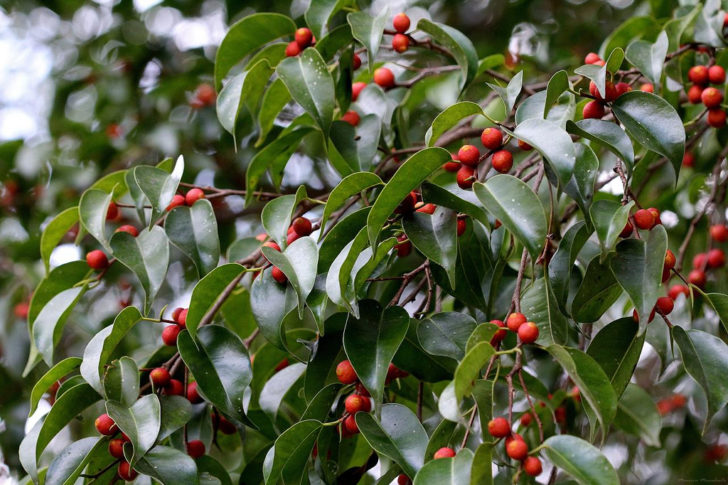
at home, it blooms extremely rarely; in nature, ficus inflorescences look like red peas
Optimal lighting mode
When caring for ficus Benjamin at home, it is important to organize the right lighting. The plant does not tolerate strong darkening and direct sunlight.
The lack of light can be determined by stopping the growth of the flower. The trunk does not lengthen, the crown does not increase in size, no new leaves are added.

ficuses will “revive” the cold interior of the bedroom
Exposure to direct sunlight causes the plant to shed its foliage. The branches are also noticeably drying up and withering. Even if the tree is provided with abundant watering during this period, it is not possible to improve its condition in most cases. The only way out is to move the pot to a place protected from direct sunlight.
The optimal location of the flower is a bright room with access to fresh air. It can be a balcony with blinds or curtains on the windows, an attic, a veranda and other options. Scattered light creates ideal conditions for the normal growth of ficus.

a small pot of ficus creates an oasis corner in a snow-white dining room
When the average daily temperature exceeds 15-16 degrees, it is useful to take the ficus out into the fresh air. In autumn, with the onset of night cold, the pot is transferred to a warm room.
back to index ↑Irrigation Features
This houseplant requires high humidity. Although, under the recommended lighting conditions, it calmly tolerates short periods of drought. For example, when the owners leave, on especially hot summer days.

high voluminous ficus looks great in spacious rooms with high ceilings
The period of intensive growth lasts from mid-April to October. At this time, it is necessary to provide the tree with abundant watering and high humidity. The topsoil must be constantly moist. To do this, it is recommended to water the plant every other day, with a small amount of settled water, distributing it evenly over the surface.
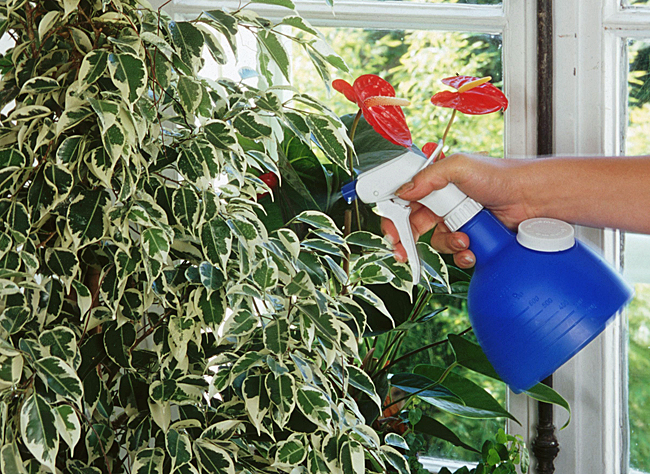
from April to October, Benjamin's ficus needs abundant watering
In hot weather, the edges of the leaves often dry out, which worsens the appearance of the plant. To avoid this, the crown must be sprayed with a spray bottle. On especially dry days, when the air humidity is at its lowest, it is useful for a tree to arrange a shower.
To do this, the root part must be covered with a layer of polyethylene so that water flows do not erode the surface of the earthen clod. The protective coating should be tied to the trunk with an elastic band or cord, completely covering the pot with it. Put the plant at the bottom of the bath and turn on the shower, directing the streams of water to the crown of the tree.

Benjamin's ficus complements the eco-design of the bedroom
This procedure has a beneficial effect on the flower:
- dust is washed off the surface of the leaves;
- improved moisture inflow;
- increases the air permeability of the foliage.
A shower for indoor ficus Benjamin can be arranged no more than once every two weeks and only in the summer. You can also carry out this procedure if the plant needs to be restored after exposure to the sun or in a hot, stuffy room. In this way, moisture can be replenished quickly and efficiently.
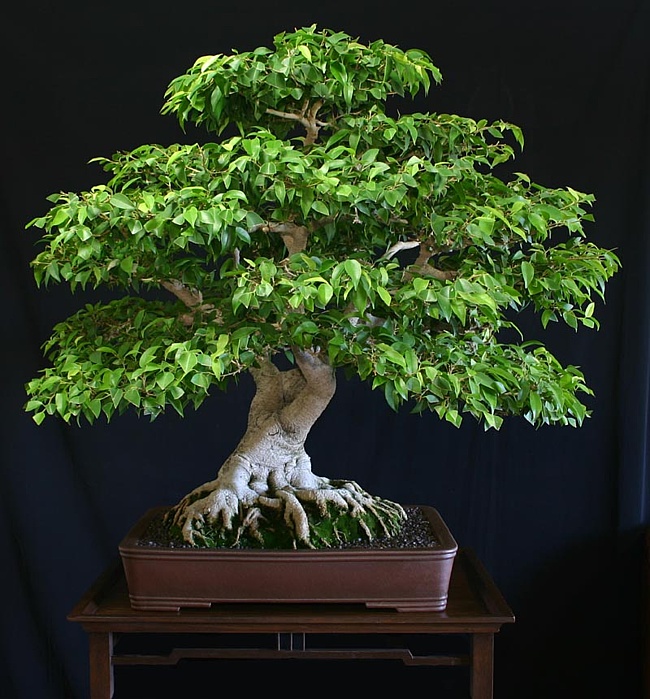
transplanting ficus is best in spring and summer
Starting in October, watering should be limited to once or twice a week. In this case, it is better to put the pot away from heating appliances. Dry, warm air harms the foliage, contributes to the deterioration of the general condition of the tree.
Until April, it is enough to irrigate according to the following scheme:
- Once a week, pour enough water into the pot so that a smaller part of it flows into the pan. This will be a sign that moisture has passed through all layers of the soil.
- Additionally, 3-4 days after the main watering, evenly spray water with a spray bottle over the entire surface of the earth. Thus, the top layer will not dry out, which is an important condition for maintaining the health of the plant.

ficus Benjamin in the living room decorated in a classic style
At the end of the winter period, the tree crown often becomes lethargic, even if all the recommendations and rules for caring for Benjamin's ficus at home are followed. If there is no massive leaf fall, then this may be a sign of a lack of nutrition. Normally, plants, like humans, are deficient in nutrients at the end of the autumn-winter season.
back to index ↑make-up
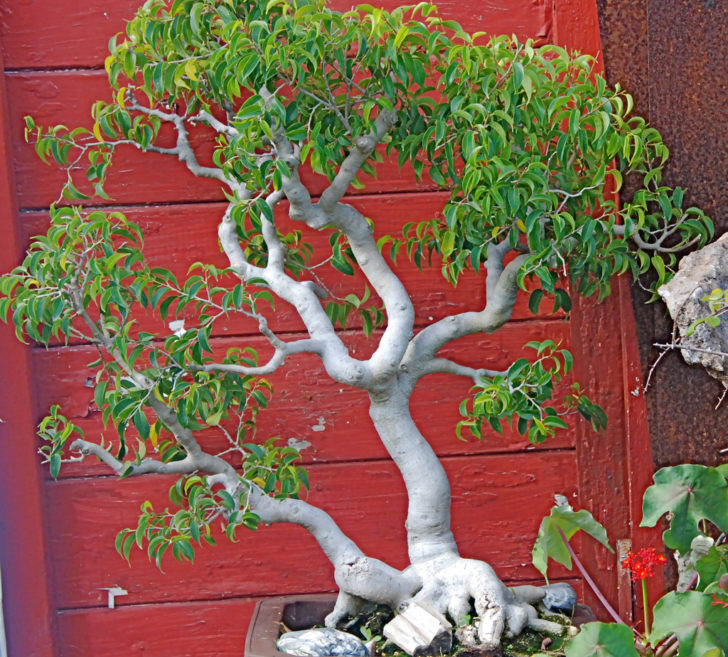
in spring, the soil must be nourished with mineral fertilizers
In April-May, it is recommended to add various fertilizer complexes to the usual watering.
- Feeding the tree is important to carry out in moist soil.
- It is optimal to use mineral, water-soluble fertilizers.
- Avoid getting the nutrient solution on the roots and trunk of the tree. This may cause a burn.
- Feeding is enough to carry out once every two weeks.
For the period from April to October, the decorative ficus will be nourished and store the necessary nutrients for the whole winter.
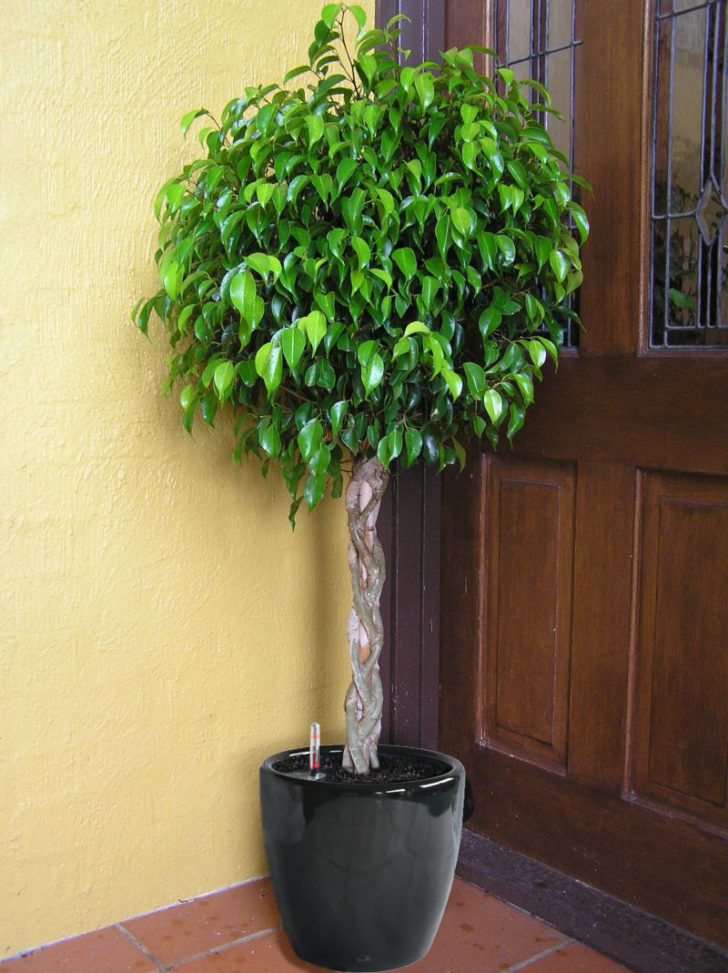
large pots of ficus with a spherical crown of leaves are best placed in the corner
Correct transplant rules
It is best to transplant the plant in May-June, when it wakes up and adapts a little to the summer light regime. However, you should have time to carry out the procedure before the onset of heat.
The best way is transshipment. Execution Method:
- Separate the earthen ball from the walls of the pot. If the container is plastic, it is enough to knead it a little by pressing on the side surfaces.
- Prepare a pot 2-3 cm wider in diameter than the previous one.
- At the bottom of the new container, arrange drainage.
- Release the root part of the flower, remove it from the pot by pulling the stem.
- Place the roots in a new container.
- Fill the free space with soil mixture.
- Seal the surface with your hands.
- Moisten the ground.
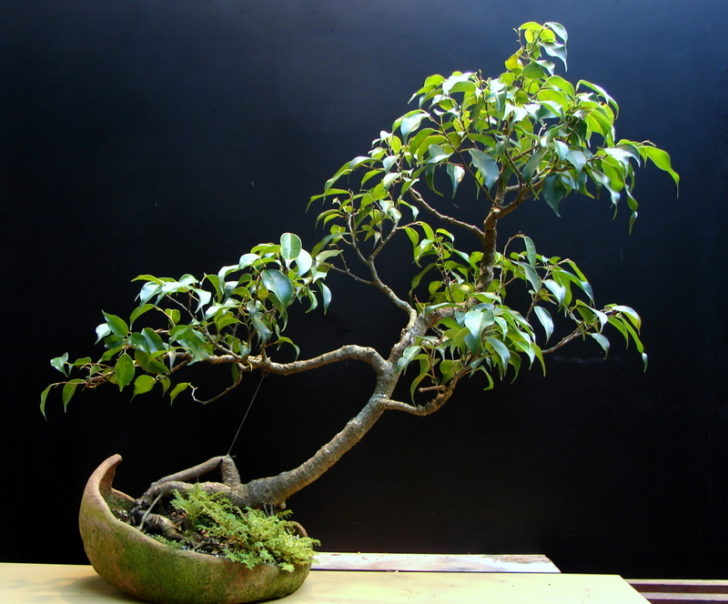
ficus does not tolerate drafts
For adult plants, provided that the diameter and depth of the current pot correspond to the size of the root part, it is enough to replace the topsoil. Approximately 2-5 cm of earth is carefully removed with a spatula. The vacated place is covered with fresh soil and moistened. The procedure is recommended to be carried out in the spring.
back to index ↑Pruning and propagation
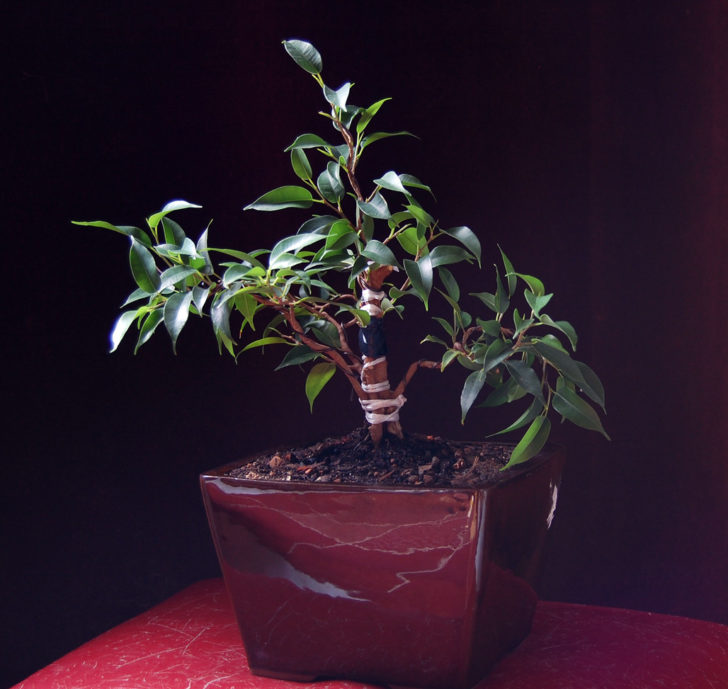
small pots with ficus can be placed anywhere
If the crown of the tree has grown enough, it is worth trimming the branches a little for better growth. To do this, use a garden pruner or a sharp knife.
The tops of the branches should be cut off, leaving a few leaves. Then the cut cuttings can be used for propagation. Pruning is best done in warm weather, optimally from May to September.
The stalk should be placed in a moistened cotton swab or gauze. When the shoot takes root, it should be dug into the soil of a light consistency and wait for germination.
back to index ↑Photo Gallery: Ficus Benjamin
- OLYMPUS DIGITAL CAMERA
Video
